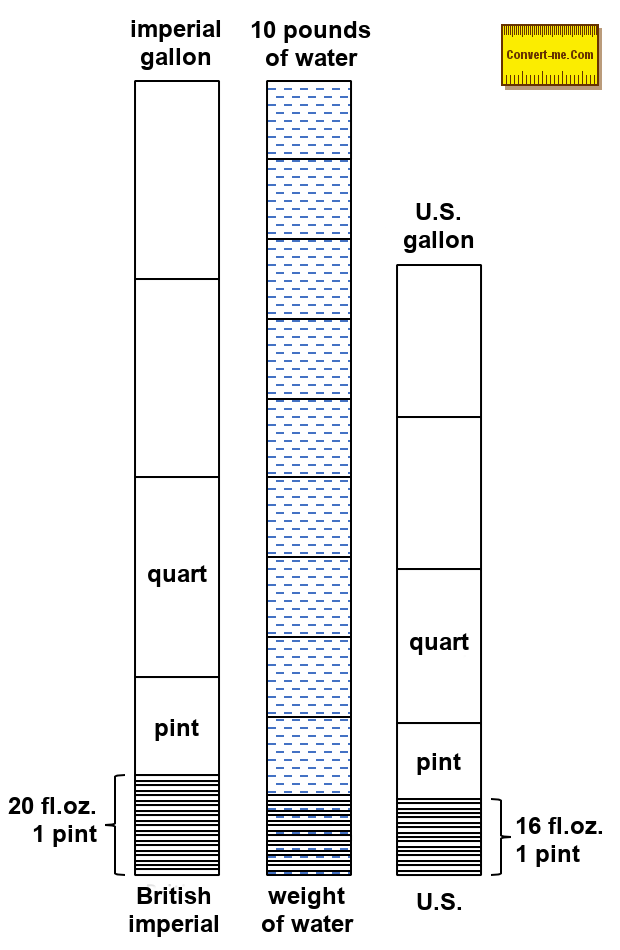How to Convert Pounds to Gallons?
Pound is a unit of mass or weight while gallon is a unit of volume or capacity. How you can convert one to another?
Two Flavors of a Gallon
Let’s start with a British Imperial gallon. In 1824 it was legally defined to be equal to the volume of 10 pounds of water at standard temperature. It means one pound of water equals to 0.1 imperial gallon.
What about U.S. gallon? It is smaller than its Imperial counterpart because it was originally based on British wine gallon that was different. The U.S. gallon holds approximately 8.35 pounds of water.
The Magic of Ounces
The first magic of ounce is the fact that one Imperial fluid ounce equals to one avoirdupois ounce of water. To tell the truth, it is not really a magic, just some math. There are 10 pounds of water in an imperial gallon, and one avoirdupois pound contains 16 ounces. It means one imperial gallon contains 16*10 = 160 avoirdupois ounces of water. Since there are exactly 160 imperial fluid ounces in an imperial gallon, the magic disappears, leaving the two ounces equal to each other.
The second magic about fluid ounces is the fact imperial and U.S. fluid ounces are very close in size. The U.S. fluid ounce is only 4% bigger than its imperial sister unit. How could that be if U.S. and imperial gallons are so different? It is because one imperial gallon contains 160 fl.oz. while one U.S. gallon contains only 128 fl.oz. This compensates the difference and makes fluid ounces so close.
The Rule of Thumb
If you need to convert fresh water from pounds and ounces to pints, gallons or cups, simply convert it to ounces first. Each avoirdupois ounce of water equals to a fluid ounce. Then convert fluid ounces to gallons or other units of volume. This conversion will be exact for Imperial units and usually good enough (4% error) for U.S. units. Of course, you can similarly convert from gallons or pints to pounds and ounces by simply doing the same conversions backwards.
This rule works for fresh water. Nevertheless, the good news is many liquids we use every day are water-based and thus have density very close to the one of water. Unless we care about high precision, we can use the same conversion for them. For example, sea water is only 2% heavier than fresh water, milk is only 3% heavier. Do you always care about such a small difference?
Simple Conversion Chart for Water-Based Substances

Please don't forget, this chart is precisely correct for pure water. It your substance is close to water, e.g. a water-based solution, the chart will be also applicable, but the actual result might be a bit off. Do not use this table for substances that are not water-based.
| Unit | Equals to | |
|---|---|---|
| Pound, avoirdupois | Imperial: | ¹⁄₁₀ gallon, or ⅘ pint, or 16 fluid ounces |
| U.S.: | ≈ ⅛ gallon, or 1 pint, or 16 fluid ounces | |
| Ounce, avoirdupois | Imperial: | ¹⁄₁₆₀ gallon, or ¹⁄₂₀ pint, or 1 fluid ounce |
| U.S.: | ≈¹⁄₁₂₈ gallon, or ¹⁄₁₆ pint, or 1 fluid ounce | |
| Gallon, U.S. | ≈ 8⅓ pounds or 133½ ounces | |
| Gallon, Imperial | 10 pounds or 160 ounces | |
| Pint, U.S. | ≈ 1¹⁄₁₆ pound or 16⅘ ounces | |
| Pint, Imperial | 1¼ pound or 20 ounces | |
| Fluid ounce, U.S. | ≈ ¹⁄₁₆ pound or 1 ounce | |
| Fluid ounce, Imperial | ¹⁄₁₆ pound or 1 ounce | |
What if my substance is different?
For substances that are not water-based the table above does not work. There is another easy solution though. We have two special online conversion pages where you pick your substance, type the amount you have, and it gets instantly converted to other units. Try these out:
- Cooking Ingredients Converter. This converter covers most typical cooking ingredients.
- Weight to Volume Converter. This one covers many other substances that are not food.
